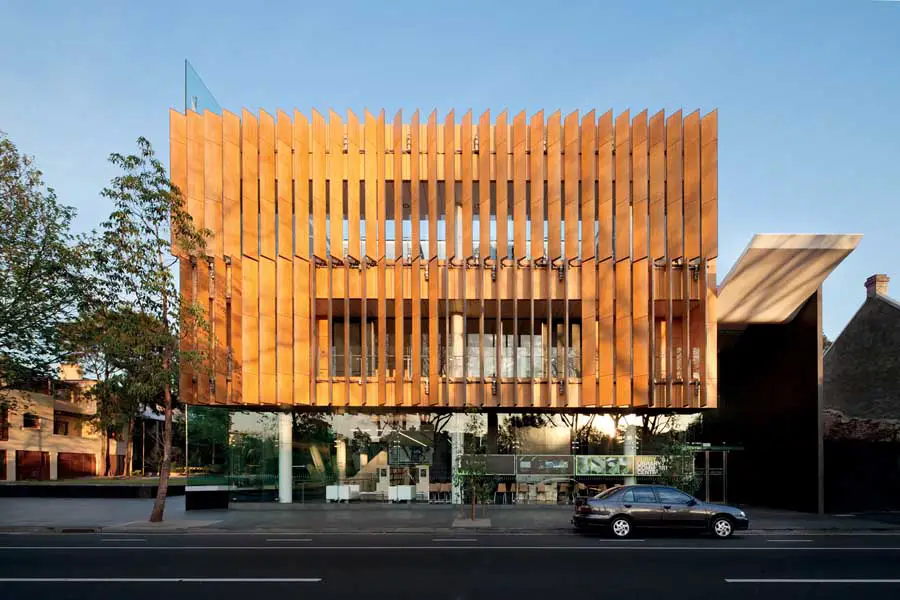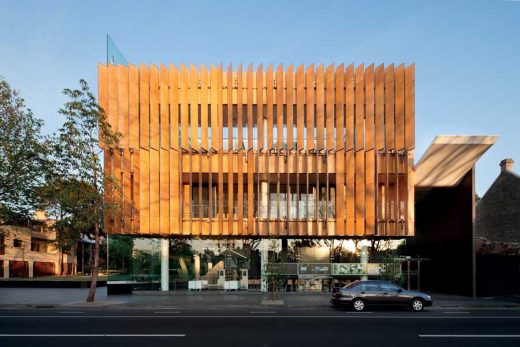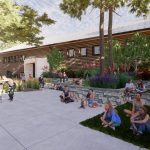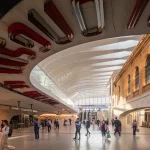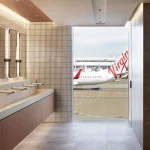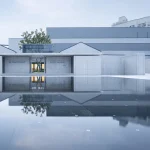Surry Hills Library Sydney, NSW Building Photos, Architect, Australia Design Project
Surry Hills Library, Sydney
405 Crown St Community Centre Development, New South Wales building design by FJMT
9 Jun 2010
Surry Hills Library and Community Centre
Location: 405 Crown Street, Surry Hills, New South Wales, Australia
Design: Francis-Jones Morehen Thorp
Architect’s statement
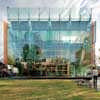

images : John Gollings courtesy by FJMT
Community hybrid : equity, aspiration and sustainability
This project is prominently located in the heart of Surry Hills, an inner-city suburb of Sydney whose community is characterised by a diversity of age, income and cultural backgrounds. The architectural context is also diverse: residential apartments, terrace housing, shops and commercial/industrial premises vary in scale though their architectural style is predominantly Victorian.
The site is very constrained, measuring just 25 by 28 metres and bound on three edges by roads: Crown Street, the main street of Surry Hills, to the east and two residential streets to the south and west.
The project’s brief was developed in close consultation with the very active local community. The key approach that emerged from these discussions was that the community wanted a facility that everyone could share.
Rather than only a library or a community centre or childcare centre, it became clear that it was important to have all of these facilities together in one building, in one place. In this way the building became a truly shared place where the whole community could meet and use in different ways. Important, too, was for the building to represent and reflect the community’s values.
In response we developed what for Sydney is a new type of public building. It is not a singular typology, for which there are many precedents, but a hybrid public building that is many different things in one: a library/resource centre, community centre and childcare centre all integrated into one modest building and accessible by all.
Transparency became an architectural theme at many levels, allowing an inviting and welcoming building that is accessible and open to public view. At the same time it was important that the building was not merely ‘transparent’, or only expose what is accommodated within, but that it represented and embodied the values of the community. Accessibility, openness, transparency and sustainability were key values as was a general sense of aspiration.
From our early studies, four integrated formal elements emerged: a new simple open space and platform, a prismatic glass environmental atrium, a suspended ‘U’ shaped timber form and a transitional foyer space.
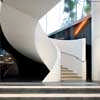
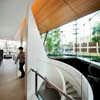
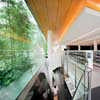
images : John Gollings courtesy by FJMT
On the southern edge, the Collins Street road closure was converted to a modest public park with a raised grass platform. This new space extended the function of the building and reasserted itself as a public place.
The tapered glass atrium evolved in response to the ambitious sustainability objectives of the project, and equally to the sense of layered transparency and the project’s aspirational quality. The series of glass prisms creates an open, transparent façade, akin to an open dolls house, and addresses the new open space so that all the different activities of the centre are visible and displayed, encouraging participation.
The timber ‘U’ form embraces the prismatic environmental atrium and orient both towards the south and the new little park. The ‘solid’ sections of this timber form are made of automated louvre systems that filter and control sunlight and view. This warm timber form is lifted above the ground to create transparency and accessibility.
The foyer space is a lower transitional form that mediates the scale of the building against the adjacent shops while creating a welcoming, transparent entry. Suspended cloud-like roof profiles bring daylight into this space and extend out above the street to mark the entrance.
The environmental atrium has become emblematic of the centre and clearly identifies the new building and public place. Looking from the new park through this prism façade, the functions of the building are apparent.
The library on the ground and lower-ground levels contains a diverse borrowing collection of approximately 30,000 items, local history collections, some reference material and public access computers. The community centre on level one comprises a function facility for 125 people and adjoining verandah, meeting rooms, commercial teaching kitchen, Neighbourhood Centre administration offices and amenities.
On level two, the childcare centre provides accommodation for 26 children in two groups (1–2 and 2–5 years) and includes an outdoor landscaped play space with automatic shade roof.
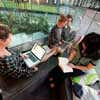
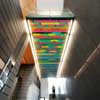
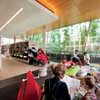
images : John Gollings courtesy by FJMT
A key project objective was to establish a new Australian standard of excellence for environmentally sustainable design in civic buildings. The building incorporates many sustainable design innovations and seeks to integrate these into the architecture and explore the expressive potential of such systems. This is most evident in the environmental atrium.
The environmental atrium’s series of triangular, tapering airshafts draw in clean outside air and passively cool it. Experimental use of plants to bio-filter pollutants is integrated in the gardens of specially selected plants within these glass enclosures. Natural daylight is filtered through these layers of glass and garden and flow deep into the interiors.
The array of environmental initiatives intrinsic to the design also include a thermal labyrinth for passive filtering and tempering of the air, solar-tracking timber louvre systems, automated fabric shading, mixed mode ventilation, extensive photovoltaic array, geothermal cooling bores, green roof, rainwater collection and recycling, and sustainable material selection.

image : Andrew Chung courtesy by FJMT
Computerised building management and control systems (BMS) automatically monitor and control the internal environmental conditions of the building, adjusting the ventilation and sunshade louvres throughout the day to control heat load, light and shade, and switching lights on and off when required. The BMS also monitors and records both electrical and hydraulic systems to maximise the environmental efficiency of the building and identify system faults.
The centre has been embraced by the local community since its opening. It is a welcoming community place for all ages and all social groups. It provides facilities that embody the values of equity of access to information and resources that are essential to building communities.
Richard Francis-Jones, Design Director – Francis-Jones Morehen Thorp
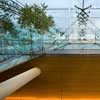
image : Mathieu Faliu courtesy by FJMT
Surry Hills Library Sydney – Building Information
Owner: City of Sydney Council
Client and Project Management: City Projects Division, City of Sydney Council
Architect: Francis-Jones Morehen Thorp (fjmt)
Landscape Architect: Francis-Jones Morehen Thorp (fjmt)
Consultant Team:
Structural: Taylor Thomson Whitting
M&E: Steensen Varming
Hydraulic: Warren Smith & Partners
QS: Davis Langdon
Acoustic Consultant: Acoustic Studio
Fire: Arup Fire
Acoustics: Noisebox
Accessibility Solutions: Rider Levett Bucknell Collider
Managing Contractor/Builder: WBHO Pro Build
Project Address: Surry Hills Library and Community Centre, 405 Crown Street, Surry Hills NSW 2010
Built area: 2,120 m2; 770 m2 landscape
Timeframe: May 2007: Construction start ; May 2009: Completion
Surry Hills Library Building images + information from Francis-Jones Morehen Thorp, architects
Francis-Jones Morehen Thorp – FJMT
WAF Awards 2011 – Shortlisted in Civic and Community Category
Phone: +61 2 8374 6230
Location: 405 Crown Street, Surry Hills, NSW, Australia
New Architecture in Sydney
Contemporary Sydney Buildings
Sydney Architecture Designs – chronological list
Sydney Architecture Tours by e-architect
Architecture Walking Tours by e-architect
Another key Sydney building by Francis-Jones Morehen Thorp (FJMT):
Latest Sydney building by Francis-Jones Morehen Thorp (FJMT):
Sugar Dock, Sydney, Australia
A recent Australian building by Francis-Jones Morehen Thorp (FJMT):
Bayside Police Station, Melbourne
Surry Hills Buildings – Selection
Surry Hills Apartments Building
Turner + Associates
Surry Hills Building
Small House
Domenic Alvaro, Woods Bagot
Surry Hills House
Sydney Architecture – Selection
Regent Place – Lumiere
Foster + Partners with PTW
Regent Place
The Bond, 30-34 Hickson Road, Millers Point
Lend Lease design with PTW Architects
The Bond Sydney
Comments / photos for the Surry Hills Library Sydney Architecture page welcome

